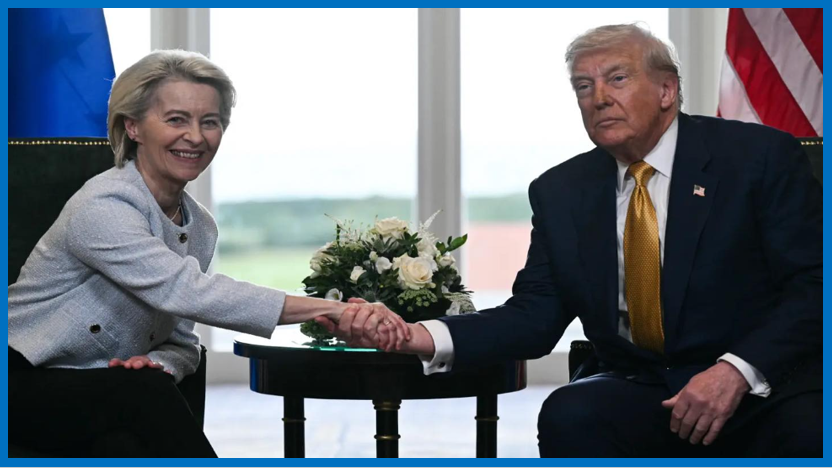Brussels/Washington — The United States and European Union have formalized a sweeping trade framework that caps tariffs at 15% on key European exports and secures over $1.3 trillion (A$2.02 trillion) in EU spending pledges through 2028. The agreement, announced Thursday, marks a significant shift from the volatile tariff landscape of previous years and is expected to stabilize markets, boost bilateral investment, and improve regulatory alignment.
Effective September 1, the U.S. will apply the capped 15% tariff rate to a broad range of EU goods, including pharmaceuticals, semiconductors, and wood products. This represents a sharp reduction from the Trump administration’s earlier tariff threats, which included:
- Pharmaceuticals: Proposed tariffs of up to 250% now capped at 15%
- Semiconductors: Threatened rates between 100% and 300% now capped at 15%
- Automobiles: Existing tariffs of 27.5%, with threats of increases to 30% now capped at 15%
- General EU imports: Blanket tariffs reaching 30% in some categories now capped at 15%
Under President Biden, many of these tariffs were suspended or restructured, including the replacement of steel and aluminum duties with a tariff-rate quota system. The new framework builds on that momentum, offering predictability and a pathway for deeper economic cooperation.
Here’s a breakdown of key tariff and policies under the Biden administration:
🇺🇸 Tariffs Under the Biden Administration
| Sector | Tariff Status | Details |
|---|---|---|
| Steel & Aluminum | Suspended tariffs (TRQ system) | Biden replaced Trump’s 25% steel and 10% aluminum tariffs with a tariff-rate quota (TRQ) system, allowing up to 3.3 million metric tons of EU steel and 384,000 tons of aluminum tariff-free. |
| General EU Imports | Capped at 15% | Blanket tariffs reduced from 30% to 15% under a new framework. |
| Automotive Sector | Lowered from 27.5% to 15% | Conditional on EU legislation reducing levies on U.S. industrial goods. |
| Pharmaceuticals | Capped at 15% | Previously threatened with 250% tariffs under Trump; now stabilized. |
| Semiconductors | Capped at 15% | Biden maintained the cap after Trump proposed 100%–300% tariffs. |
| Agricultural Goods | Preferential access granted | EU agreed to open markets for U.S. pork, bison meat, tree nuts, and more. |
The most notable different is the substantial pledged EU spending running into an estimated $1.3 Trillion as detailed below.
Sector-Specific Relief and Strategic Investment
The automotive sector will benefit from conditional tariff relief. EU car manufacturers will face the 15% rate only after Brussels enacts legislation to reduce industrial tariffs on U.S. goods. While this halves the previous 27.5% rate, industry groups remain cautious. The German Association of the Automotive Industry warned that even the reduced rate could cost billions annually during the sector’s transition to electric and sustainable technologies.
Several strategic sectors will see exemptions. The U.S. will apply standard Most Favored Nation (MFN) rates—typically below 5%—to European cork, aircraft parts, and generic pharmaceuticals. Both sides have also agreed to mutual recognition of automotive standards and enhanced cooperation on cybersecurity assessments.
In return, the EU has pledged to:
- Purchase $750 billion in U.S. energy products—including LNG, oil, and nuclear materials—over three years
- Procure $40 billion in American AI chips
- Invest $600 billion in strategic U.S. sectors by 2028
- Increase spending on American defense equipment, though no specific figure was disclosed
While these commitments are described as “intended and expected,” analysts note that enforceability remains uncertain.
Expected Outcomes and Strategic Implications
The framework is expected to deliver several key benefits:
- Tariff Stability: Businesses on both sides of the Atlantic can plan with greater confidence, reducing the risk of sudden cost spikes.
- Investment Growth: The $1.3 trillion in EU pledges could stimulate U.S. manufacturing, energy, and tech sectors, creating jobs and expanding exports.
- Regulatory Alignment: Mutual recognition of standards and cooperation on cybersecurity could streamline compliance and reduce barriers for cross-border trade.
- Climate and Sustainability Dialogue: Brussels has committed to addressing U.S. concerns about its deforestation regulation and carbon border adjustment mechanism, offering flexibility for small American businesses.
This agreement marks President Trump’s first major bilateral trade deal of his current term. While welcomed by many as a stabilizing force, critics remain skeptical about whether Europe’s ambitious spending commitments will materialize as promised.



